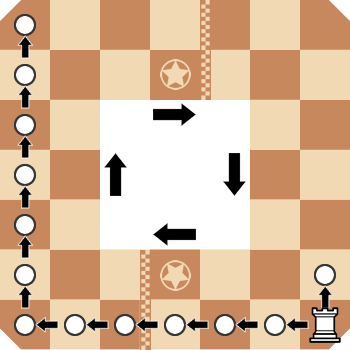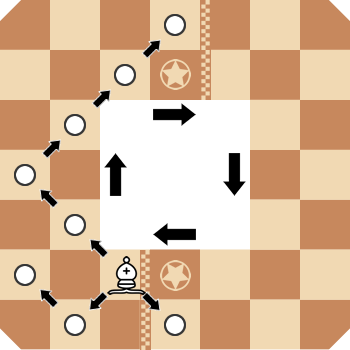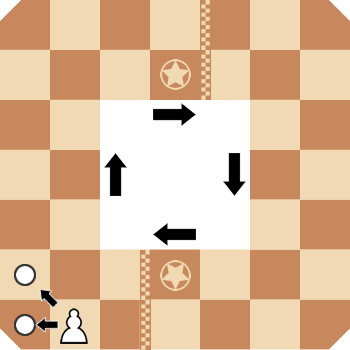Rules
Board and pieces

The board in a double ring of 40 squares made from a 7 x 7 with a 3 x 3 hole in the center. There is an inner ring and a outer ring. Also, it is convenient to see 4 zones, South, West, North and East.
Each side has 6 pieces only: 1 King, 1 Bishop, 2 Rooks and 2 Pawns.
White plays first.
All captures are by displacement as for Chess.
Moves and Rules
The play is mostly clockwise: generally speaking, the pieces move mainly ahead and have only limited motion backward. At every corner of the board, the pieces rotate 90°. Details follow.
All pieces change their orientation (rotating 90° clockwise) when they land on a corner or bend space (a1, b2, a7, b6, g7, f6, g1, f2).

King
The King moves and captures exactly as in Orthochess to any adjacent square but never to a square where it can be captured. It is the only piece to have a symmetric move.


Rook
The Rook slides any number of squares forward or sideways along the row or column. Also, it can move 1 square only orthogonally backward. It never slides backward. On the external ring, they have one rebound allowed on the corners of the board.




Bishop
The Bishop slides diagonally forward any number of squares with one rebound allowed on the sides, external and internal, of the board. Also, it can move 1 square diagonally backward. It never slides diagonally backward.
One may note that the white diagonals are forming another ring joining the mid-points of the external sides. The Bishop is very powerful there.




(It can go to a2 only if it goes through b1)

Pawn
The Pawn moves and captures forward straight or diagonally. When reaching the starting square of opposite Pawns it promotes to either a Rook or a Bishop. (Promotion to a Bishop upon dark squares is not recommended)


(b1 is ahead when Pawn is on c2)

(b2 is sideway when Pawn is on b1 because it has not turned yet)

(b2 is ahead when Pawn is on a1, because it has turned)

End of the Game
There are 2 ways to win the game:
- Ckeckmate the opposite King
- When the King reaches the starting square of the opposite King, but only if had turned clockwise.
Pat is a draw. A 3 times repetition also.
Credits
Jocly implementation
 Rollerball has been invented by Jean-Louis Cazaux.
Rollerball has been invented by Jean-Louis Cazaux.
Site:http://history.chess.free.fr/
